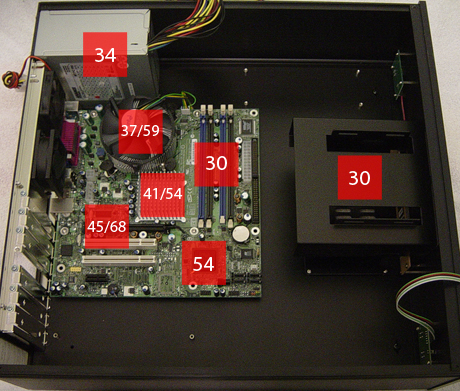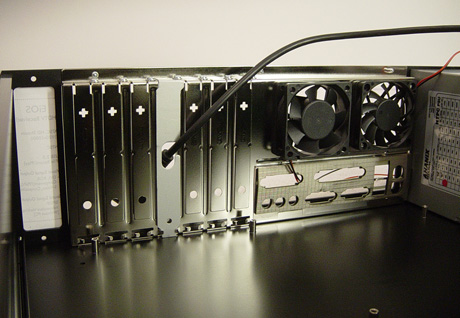Intel's Long Awaited BTX Form Factor
by Purav Sanghani on November 15, 2004 5:31 AM EST- Posted in
- Cases/Cooling/PSUs
Thermals Desktop ATX
We tested our D915GUX board and Pentium 550 CPU in Ahanix's D.Vine 5 HTPC chassis, the successor to the D.Vine 4 we reviewed last month, since it had the size of a typical mid tower case yet took on the form of a flat lying desktop case like the B300 to give a better idea of how this hardware performed in a case with sizes we are used to. Unlike Opus Technologies, Ahanix has a great deal of products, many of them cases which is their main focus. The first case we reviewed from Ahanix was their Black Knight. The Black Knight performed well in our thermal benchmarks while averaging at 50dBA in sound We again measure temperatures of the ambient air inch by inch to show how each component affects various areas of the case.
Click to Enlarge
It is evident that the warmest region in our desktop ATX system is between the CPU, Northbridge, and PCIe VGA card followed by the power supply. We also notice how the rear exhaust fans are pulling the warm air towards them to the outside. The D.Vine 5 has an extremely large footprint, 17" in width by 18" in depth, so there are many areas which are not being exposed to warm air such as the front corners as well as the left side of the case.

Click to Enlarge
We see here that the CPU, Northbridge heatsink and the PCIe VGA card are the hottest components in the system. The Southbridge also ran extremely hot at 54 degrees, but it is too small to have as great of an effect on the ambient air around it as did the other three. The power supply, on the other hand, measured to be 34 degrees which had a great affect on its surrounding air.

Click to Enlarge
Again, since the D.Vine 5 lies flat instead of upright like the TT-501 does, heat pockets mainly occur over the equipment giving off the heat instead of at the top of the case (the right side in this case) near the power supply.










77 Comments
View All Comments
HardwareD00d - Monday, November 15, 2004 - link
Instead of spending all the money to research BTX, Intel should have just made watercooling standard on the Prescott CPU. Apple could have said they stole the idea from them like everything else ;)Omega215D - Monday, November 15, 2004 - link
It looks like Intel needs all the cooling it can get. I found an interesting article at Toms Hardware and here;s the closer about its heat problem "So, should a vendor release a product that is only able to run at its maximum performance under special circumstances? The fastest processors certainly are very exclusive devices, but that should not cause more troubles than necessary. The customer wants products that simply work! Think about that before releasing faster products, Intel." All I can say is wow, because I can remember my P3 866 didn't need all that cooling though now I moved on to AMD.HardwareD00d - Monday, November 15, 2004 - link
It sounds like you can essentially get the same thermal performance from an ATX case by adding 1 additional case fan.At least Intel has decided not to push this new form factor down peoples throats. Honestly, that's what I figured they'd try to do.
Gatak - Monday, November 15, 2004 - link
To have the powersupply and drive bays at the bottom is a good thing. It will keep the temperature more balanced inside the case and also provide more room at the top for cards and for exhaust fans, rather than craming everything up there.Pythias - Monday, November 15, 2004 - link
ROFL #6!!Ecmaster76 - Monday, November 15, 2004 - link
If a retail board showed up to a review with that horrible a component layout, it would be figuratively flogged.I find that the review was somewhat flawed since it failed to see what would happen with a discrete graphics card in the box. If one was used, I didn't spot it in the screenshot of the full ATX or uBTX screeshots, and it wasn't mentioned in the text.
Finally it should be mentioned that many people have theorized that the BTX layout would not work well for the Athlon64's onboard memory controller because of issues with trace layout. I'm no expert, but it does look like it might get a little tight.
ksherman - Monday, November 15, 2004 - link
"Anand's *vacation* work trip to Taipei..."Probably one of the funniest things i have read in one of your reviews.... ;)
raskren - Monday, November 15, 2004 - link
As always, so much Intel backlash, simply because, its Intel.This is how cases should have been done originally. Align all the hot components and put a fan in front and behind them. Makes sense, right?
Current ATX design is "put a fan on every hot item you have". At least that's how my case is.
LoneWolf15 - Monday, November 15, 2004 - link
To me, BTX looks like a winner for only one niche: small form factor business desktops. By that definition, I don't include Shuttle's wonderful SFF PC's which work best for home and HTPC enthusiasts. The microBTX form factor looks great for an office environment where quiet operation is a real plus, as well as power consumption, and since business PC's don't need to be cutting-edge, middle-end processors can be used that don't generate a lot of heat.Tor the enthusiast however, BTX looks like a bust to me, more of an attempt by Intel to throw the market out of whack, specifically AMD's market. Enthusiasts already have case designs meant to exhaust a lot of air and keep systems cool. Many enthusiasts LIKE a little bit larger case so that they have more expansion room, with the exception of their HTPC, and so that they can house a decent power supply for that expansion.
I see HP, Compaq, IBM, and other mainstream business computing giants adopting BTX; it will probably do well in the business market as well as in mass retail, where OEMs would rather make a system with less fans to fail and at cheaper cost. That's a pretty big sector for profit of course, but this form factor, IMO, leaves PC enthusiasts out in the cold.
Beenthere - Monday, November 15, 2004 - link
BTX is obviously NOT a great design. Intel changes sockets, Mobo and other specs periodically to FORCE people to update to their latest crap. Don't expect a rush to BTX. It's another Intel spec unlikely to ever gain foothold...For those who don't already know you can do wonders for ATX case cooling with "managed airflow". By actually directing incoming cool air to the heat sources and isolating the CPU fan from warm air in the case, no one really needs a BTX case and your PC will run much cooler with managed airflow.
While Intel definitely needs a tornado inside a box to cool their defective 90 nano CPUs, the BTX standard is just another Intel marketing scam for all practical purposes.
Just say NO !